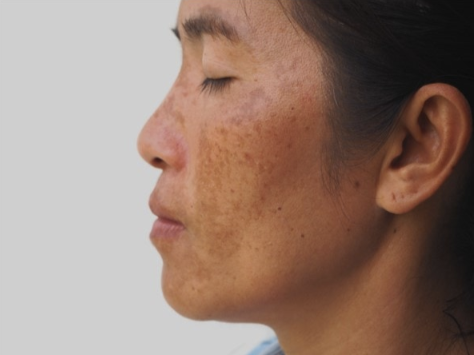If freckles are a symbol of youthful energy, melasma might very well be a symbol of midlife.
When it comes to the latter, of course, we’re putting things lightly.
Melasma is often a natural part of aging. However, it can also be a visual sign of internal changes that may be associated with health problems. Regardless of the cause, melasma can affect your self-confidence and body image, and understandably, you might want to get rid of it. This post will take a deeper look at melasma, along with its causes and treatments.
Melasma Description
Also known as the “mask of pregnancy”, melasma takes the form of brown or gray-brown patches on the face. It affects women more often than men and usually appears during pregnancy (hence its name) and the hormonal changes it produces. Melasma affects people with darker skin more often, but it can strike anyone regardless of ethnicity, skin tone, and age.
If you zoom up closer on a face affected by melasma, you’ll notice some other common traits as well. The most common is the location of melasma patches. They usually show up on the cheeks, the bridge of the nose, and the forehead. It’s also common on the upper lip and chin. However, some sufferers find it on their necks, shoulders, and even their forearms.
Melasma can be distressing to look at. If you once enjoyed relatively clear skin and now deal with uneven, colored skin patches, it can seem unfair. Of course, addressing it involves understanding its origin.
Melasma Causes
First off, the exact cause of melasma is hard to pin down because there is no exact cause—it’s a multifactorial disease. What we do know is some structural changes to the skin and melanocytes, the cells that produce melanin, go into overdrive and produce dark patches on the skin that don’t fade. Researchers have also identified hundreds of melanin-regulating genes that may trigger the development of melasma.
Of course, some known triggers bring on the condition as well.
Known Melasma Triggers
- Sun/UV ray exposure: Although some time in the sun can give you a glowing tan, it can cause melasma for some. This is due to the overproduction of melanocytes (which produce melanin), which can lead to dark patches on the face.
- Hormonal changes: Changes in hormone production and levels can also lead to melasma. That’s why it’s commonly seen in women who are pregnant (hence its nickname, the “mask of pregnancy”), are on birth control pills, or undergoing hormone therapy.
- Skin irritation: Some skincare products can cause irritation, which may lead to increased melanin production. As a result, that could lead to melasma in those who are predisposed to developing it.
- Medical conditions: Although less common, some people develop melasma as a result of a medical condition, such as thyroid problems or even excessive stress.
Melasma Treatment: Choosing the Best Option for You
Melasma can be quite a stubborn condition in the sense that it lingers. If you try to address it on your own, it can take a lot of trial and error to find the best way to minimize its appearance. But melasma is very treatable with the right approach, especially if you choose an in-clinic treatment protocol. For example, here at PSSC, we recommend a few procedures to help keep melasma in check.
Chemical Peels
During a chemical peel, a practitioner will apply a solution that removes dead skin cells, causing them to peel away. That results in the stimulation of new skin that’s smoother and blemish-free, meaning the appearance of melasma lessens.
For melasma, specifically, the chemical peel contains specially formulated compounds that suppress hyperactive melanocytes, so the production of melanin decreases. This further lightens the appearance of melasma and prevents further outbreaks. It typically takes 4-6 weeks to see noticeable results, although it can take longer in severe cases.
Microneedling
During a microneedling session, your practitioner uses a hand-held roller or electric tool to make tiny wounds in your skin—don’t worry, this doesn’t hurt. If using a roller, the practitioner gently rolls the device along your skin, or if it’s an electric tool, they’ll pulse it up and down.
Either action creates micro-injuries. In effect, these micro-injuries trigger the reorganizing of old collagen fibers, laying new collagen and elastin fibers to heal the injured areas. This rejuvenates skin in the process and lightens the discoloration created by melasma. It can take 8 weeks to see significant results with microneedling.
Laser Therapy
Of course, laser therapy is a broad term, describing many types of applications—after all, different types of lasers use different mechanisms. When it comes to melasma, some laser therapy options are more ideal than others. Fractional laser therapy makes microscopic holes in the skin to stimulate the growth of new cells, which helps restore the skin to its natural color.
There’s also Intense Pulse Light laser (IPL), which uses specific wavelengths to target the tones of skin—this too can have a restorative effect on your skin’s natural color. Then there is the Q-Switch, which delivers energy to break up melanin into smaller pieces, reducing the appearance of dark patches. This laser, in particular, is ideal for patients with darker skin.
For most laser treatments, dramatic results become apparent in 3 to 6 months.
Which Melasma Treatment is Ideal for You?
Choosing the best melasma treatment can be confusing, especially if you’ve been dealing with it for a while. If you haven’t had any success so far, you might be hesitant to choose a treatment on your own and waste more money on a bunk solution.
Here at PSSC, we can help you avoid running into another dead end, by finding you the most effective treatment for your treatment goals and budget. We conduct thorough screenings that identify what solution works best for you, so you don’t have to do multiple therapies for an ongoing period. Get in touch with us to help you find the best melasma treatment for the results you deserve.

